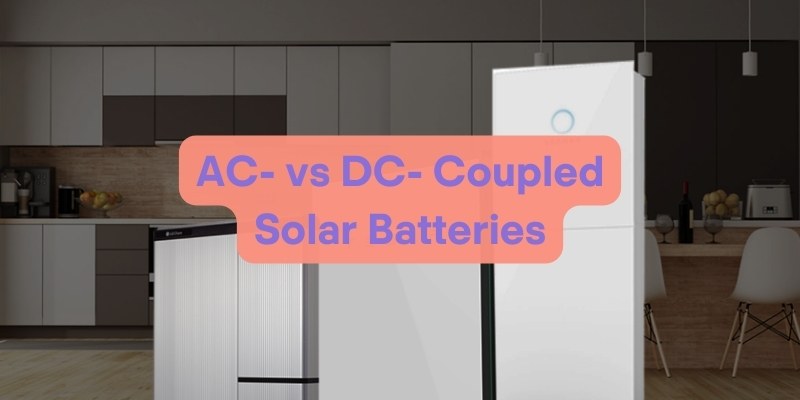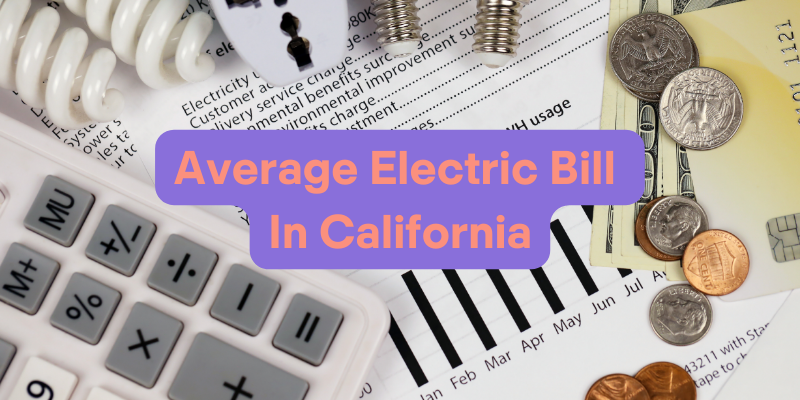
The average electric bill in California is $170 per month, based on a statewide average monthly electric usage of 571 kilowatt-hours (kWh) per month and an average utility rate of 29.84 cents per kWh in August 2023.
Of course, California is a massive state and everyone’s mix of electricity usage and utility rate is unique. So, in this article, we’ll break down the average electric bill in California a little further to account for different housing types and utility rates. We’ll also use electricity rate forecasts from California’s three largest utilities (PG&E, SCE, and SDG&E) to get a sense of what an average electricity bill will look like in the near future.
Average electricity bill by dwelling type in California
The average California electricity bill of $170 per month mentioned above is based on statewide averages for electricity usage, which lumps together studio apartments in LA and Beverly Hills mega-mansions even though they use vastly different amounts of electricity.
In fact, our analysis of data from the Energy Information Administration (EIA) found that detached single-family homes in California use on average 801 kWh of electricity per month compared to 417 kWh per month for apartments. When we multiply those new usage figures by the average utility rate, we find that the average electricity bill in California ranges from $123 to $239 per month, depending on the type of home.
Average electric bill by dwelling type
| Dwelling type | Avg. monthly usage | Avg. monthly bill |
| Detached-single-family home | 801 kWh | $239 |
| Apartment | 417 kWh | $124 |
| Mobile home | 714 kWh | $213 |
| All households | 571 kWh | $170 |

Larger bills for single-family homeowners make sense, given space heating and cooling make up a majority of electricity consumption, and they typically have more space to heat and cool. In fact, as the square footage of the dwelling increases, so does the average electricity bill.
Based on the average utility rate of 29.84 cents per kWh in August 2023, homes with 3,000 or more square feet in California have an average monthly bill of $321 per month — nearly double the $138 per month for homes with less than 1,000 square feet.

So, based on square footage and dwelling type, the average electric bill for a 1 bedroom apartment in California is likely closer to $138 per month than it is to the statewide average of $170 for the same month.
It’s worth noting that square footage is not a perfect indicator of electricity consumption. For example, a 1,500 square foot home with all electric appliances and two electric vehicles charging in the garage would likely have greater consumption than a 2,500 square foot home with all gas appliances and cars.
How much does electricity cost in California?
The other variable to consider is the price you pay per kWh of electricity, also known as your utility rate. Just like consumption, this can vary quite a bit in a large state like California.
The EIA lists the average utility rate in California in August 2023 as 29.84 cents per kWh, but there are many rates across the state that make up this average. For example, customers of San Diego Gas & Electric (SDG&E) paid over 40 cents per kWh in the first quarter of 2023, according to a May 2023 Senate Bill report, while Los Angeles Department of Water and Power (LADWP) customers paid closer to 22 cents per kWh in the first quarter of 2023 (although it has increased substantially as of June 1, 2023).
With that in mind, the average electric bill in California depends both on the dwelling type and the utility provider issuing the bill. For example, apartment owners in SCE territory pay around $130 per month while single-family homeowners in SDG&E territory pay closer to $324 per month.
The chart below shows the average bill for detached single-family homes and apartments for California’s three largest utility providers, along with the state average utility rate.
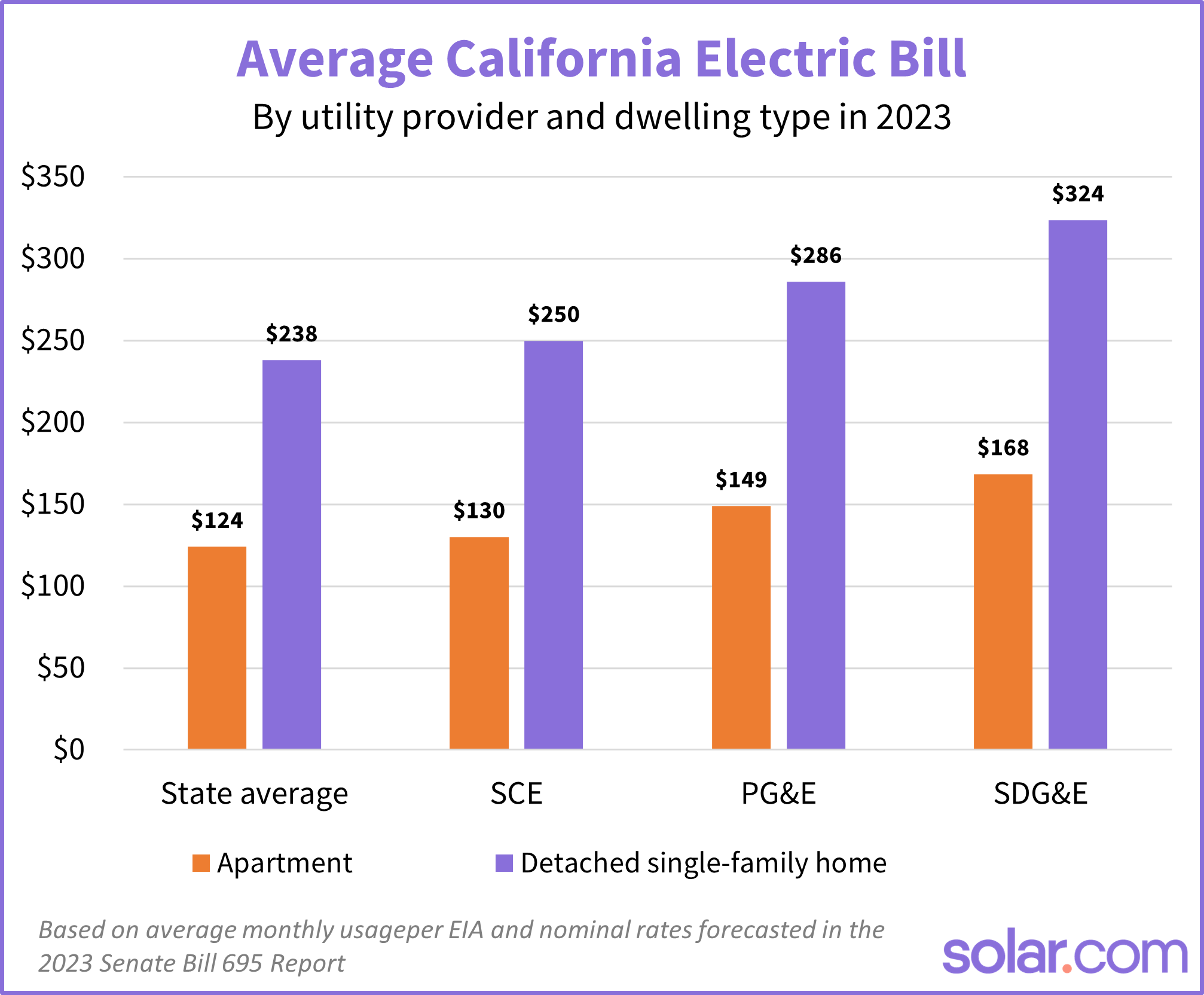
Even with relatively low electricity consumption, Californians face some of the highest electricity bills in the nation due to utility rates that are around double the national average. And, unfortunately, that trend is only expected to accelerate in the coming years.
In fact, forecasts in a May 2023 Senate Report showed residential utility rates increasing:
- 10.4% annually for PG&E, reaching 42.2 cents per kWh by 2026
- 6% annually for SCE, reaching 35.3 cents per kWh by 2026
- 10.4% annually for SDG&E, reaching 56.2 cents per kWh by 2026
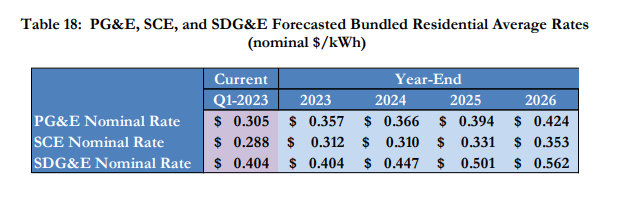
If rates increase as forecasted above, the average electric bill for IOU customers using 801 kWh per month would reach $283-450 per month by 2026, as shown in the chart below.
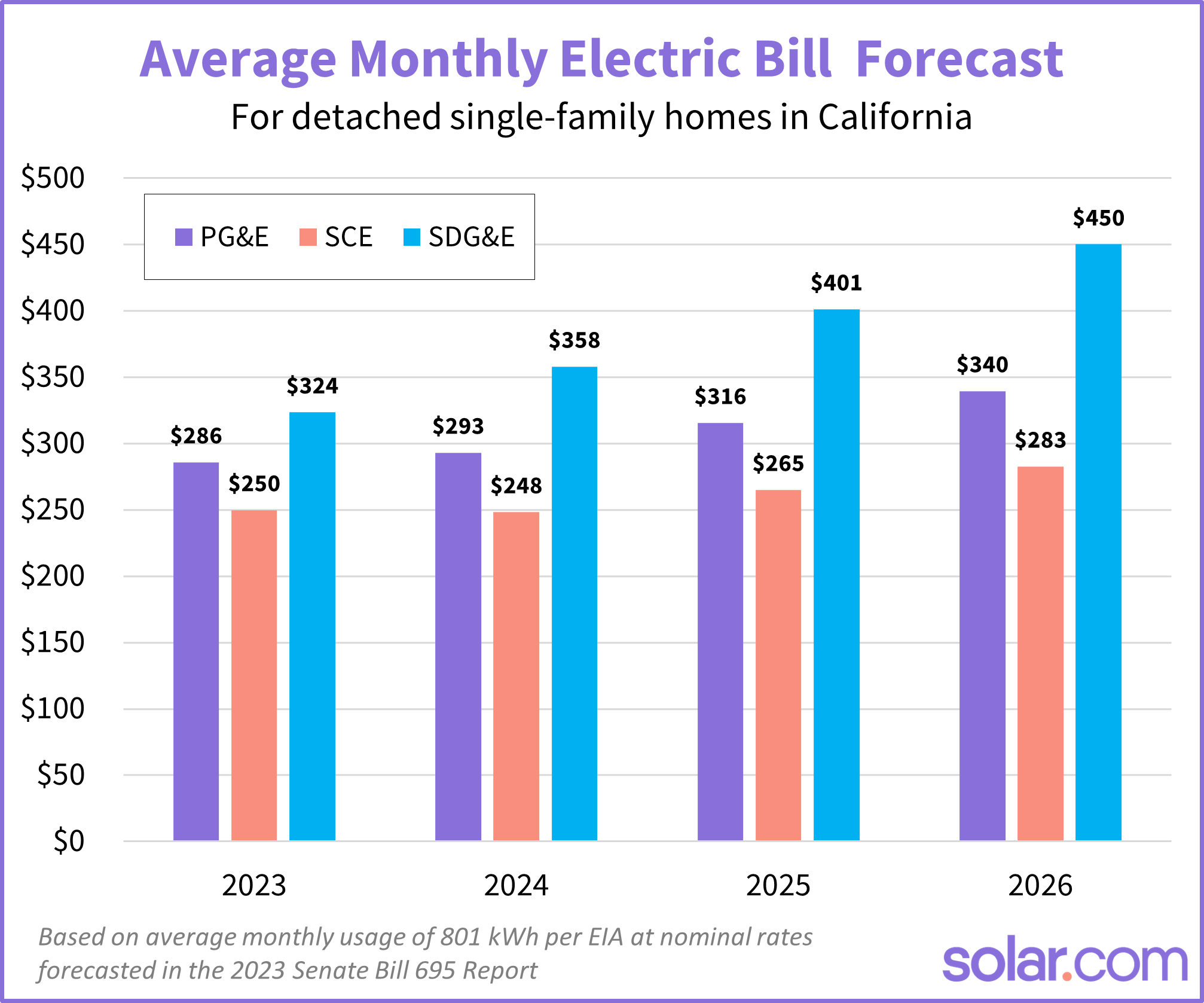
Why is electricity so expensive in California?
California’s high electricity prices are in large part due to its outdated and inefficient central grid system, which has two major challenges: Generation and transmission.
California generates around 70% of its own electricity in-state and imports the other 30% from nearby states in the Northwest and Southwest. Importing this electricity is expensive, especially in late summer when electricity consumption is at its peak and hydroelectric sources are no longer at full capacity. So, to keep up with demand, California grid operators must build more in-state generation or continue importing from nearby states.
Both routes cost money, which is reflected in utility rates.
There’s also the issue of transmission. While new wind and solar generation is relatively cheap to build, it requires new transmission lines to connect it customers — which can be expensive to build in a massive state like California. Not only does California need new transmission infrastructure, it also needs to replace existing lines that are aging and being destroyed by wildfires and other extreme weather events.
Simply put, making California’s 150-year-old central grid system work for its 39 million residents is an expensive undertaking. And much of that cost is passed onto utility ratepayers in the form of electricity rate hikes.
Fortunately, California is also overflowing with sunshine and homeowners can reduce their essential electricity costs by producing their own solar electricity and creating a more resilient grid by storing it with home batteries.

